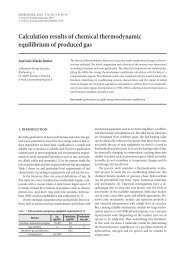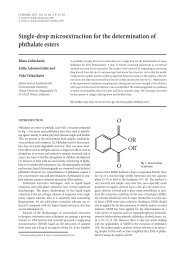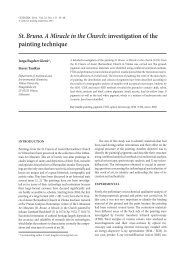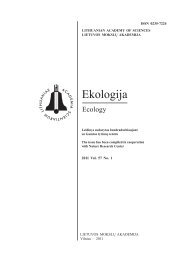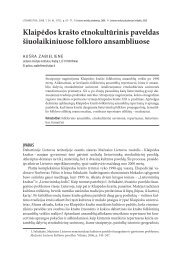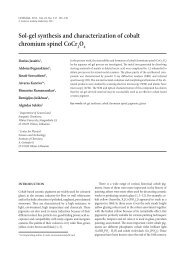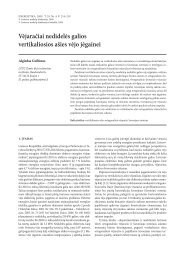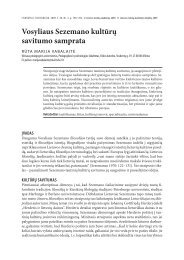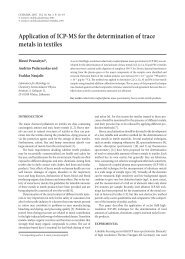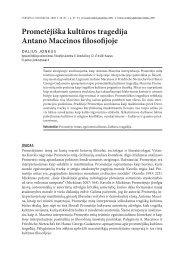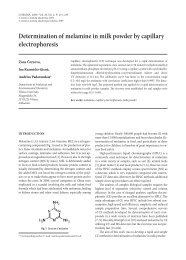Causes and consequences of the vertical migration of fine soil ...
Causes and consequences of the vertical migration of fine soil ...
Causes and consequences of the vertical migration of fine soil ...
You also want an ePaper? Increase the reach of your titles
YUMPU automatically turns print PDFs into web optimized ePapers that Google loves.
žemės ūkio mokslai. 2008. t. 15. Nr. 3. P. 36–41<br />
© lietuvos mokslų akademija, 2008<br />
© lietuvos mokslų akademijos leidykla, 2008<br />
<strong>Causes</strong> <strong>and</strong> <strong>consequences</strong> <strong>of</strong> <strong>the</strong> <strong>vertical</strong> <strong>migration</strong> <strong>of</strong> <strong>fine</strong><br />
<strong>soil</strong> fractions<br />
Jonas Mažvila 1 ,<br />
Mečislovas Vaičys, 2<br />
Ričardas Beniušis 2<br />
1<br />
Agrochemical Research Centre<br />
<strong>of</strong> <strong>the</strong> Lithuanian Institute<br />
<strong>of</strong> Agriculture, Savanorių 287,<br />
LT-501270 Kaunas, Lithuania<br />
E-mail: mazvila@agrolab.lt<br />
2<br />
Lithuanian Forest Institute,<br />
Liepų 1, LT-53101 Girionys,<br />
Kaunas distr., Lithuania<br />
E-mail: dirvo@mi.lt<br />
Generalized data on <strong>the</strong> granulometric composition <strong>of</strong> 564 <strong>soil</strong> samples taken from different<br />
<strong>soil</strong> layers have shown that <strong>the</strong> smaller <strong>soil</strong> particles <strong>the</strong> faster under <strong>the</strong> same conditions <strong>the</strong>y<br />
are leached by precipitation into deeper <strong>soil</strong> horizons. Our research has shown that Luvisols<br />
are formed in friable rocks in which from <strong>the</strong> upper layers carbonates <strong>and</strong> Ca ions have been<br />
leached out <strong>and</strong> <strong>the</strong> environment becomes less acid. A gradual shift from El horizons to Bt is<br />
characteristic <strong>of</strong> Luvisols, while in case <strong>of</strong> Albeluvisols <strong>and</strong> Podzols this process is most distinct.<br />
In s<strong>and</strong>y Luvisols, thin curvy or straight so-called pseud<strong>of</strong>ibri are formed in which fractions<br />
<strong>of</strong> clay <strong>and</strong> silt, iron compounds <strong>and</strong> orientated clays accumulate. In calcaric Cambisols <strong>and</strong> in<br />
carbonate-horizons <strong>of</strong> o<strong>the</strong>r <strong>soil</strong>s dispersion fractions coagulate <strong>and</strong> hardly migrate within <strong>the</strong><br />
boundaries <strong>of</strong> a pr<strong>of</strong>ile.<br />
Studies <strong>of</strong> <strong>the</strong> <strong>vertical</strong> <strong>migration</strong> <strong>of</strong> fractions <strong>of</strong> granulometric texture <strong>and</strong> a comparison <strong>of</strong><br />
data from elluvic, illuvic <strong>and</strong> carbonate-rich horizons have shown that transportation <strong>of</strong> clay<br />
fractions from elluvic to illuvic <strong>and</strong> carbonate-rich horizons is <strong>the</strong> most vivid in s<strong>and</strong>y loam<br />
<strong>soil</strong>s <strong>and</strong> not so vivid in loamy s<strong>and</strong>. In s<strong>and</strong>s, s<strong>and</strong>y clay loam, s<strong>and</strong>y clay <strong>and</strong> clay <strong>soil</strong>s, <strong>the</strong><br />
leaching <strong>of</strong> <strong>the</strong> <strong>fine</strong>-dispersion fraction is weak.<br />
Key words: <strong>soil</strong>s, texture, <strong>soil</strong> horizons, <strong>fine</strong> dispersion fraction, <strong>vertical</strong> <strong>migration</strong><br />
INTRODUCTION<br />
Soil is a constantly developing <strong>and</strong> changing natural body. It is<br />
an extremely complex ecosystem. Various processes take place in<br />
<strong>the</strong> <strong>soil</strong>: accumulation <strong>of</strong> organic materials <strong>and</strong> <strong>the</strong>ir decomposition<br />
<strong>and</strong> mineralization, gleyification, wea<strong>the</strong>ring <strong>of</strong> minerals,<br />
leaching <strong>of</strong> carbonates, formation <strong>and</strong> destruction <strong>of</strong> structures,<br />
brunisolization <strong>and</strong> podzolization. An important role is played<br />
by microbiological activity. Lithuanian <strong>soil</strong>s have undergone a<br />
ra<strong>the</strong>r long way <strong>of</strong> development. Soil is formed by several indispensable<br />
factors: time, climate, vegetation, relief, <strong>soil</strong> forming<br />
rocks <strong>and</strong> even <strong>the</strong> main user – man. One <strong>of</strong> <strong>the</strong> most important<br />
processes closely related to <strong>soil</strong> formation is <strong>the</strong> translocation<br />
<strong>of</strong> <strong>fine</strong> <strong>soil</strong> particles or leaching <strong>of</strong> clay particles from <strong>the</strong> upper<br />
<strong>soil</strong> horizons <strong>and</strong> <strong>the</strong>ir accumulation in deeper layers. Our<br />
conditions are favourable for this because <strong>of</strong> a sufficient amount<br />
<strong>of</strong> precipitation <strong>and</strong> ra<strong>the</strong>r loose <strong>soil</strong>s. In <strong>the</strong> post-glacial period,<br />
this process left a deep imprint in <strong>the</strong> development <strong>of</strong> <strong>soil</strong>s: it<br />
changed <strong>the</strong>ir genesis, physical, chemical properties, <strong>soil</strong> hydrological<br />
regime, <strong>soil</strong> fertility <strong>and</strong> even st<strong>and</strong> species composition,<br />
as well as <strong>the</strong>ir stability against winds.<br />
When Lithuania has become a EU member <strong>and</strong> is being<br />
integrated into <strong>the</strong> science <strong>and</strong> economy <strong>of</strong> West European<br />
<strong>and</strong> o<strong>the</strong>r countries, thus carrying out international research<br />
programs, it is urgent to have native <strong>soil</strong>s classified according to<br />
international st<strong>and</strong>ards.<br />
The new classification <strong>of</strong> Lithuanian <strong>soil</strong>s was based on<br />
expeditions <strong>of</strong> <strong>soil</strong> specialists, during which pr<strong>of</strong>iles were<br />
discussed <strong>and</strong> new taxonomic units were adjusted according to<br />
<strong>the</strong> previously used systematic list <strong>of</strong> <strong>soil</strong>s for <strong>the</strong> Baltic countries,<br />
compiled in 1953 (Систематический список..., 1953). The<br />
latter list <strong>of</strong> <strong>soil</strong>s was constantly improved <strong>and</strong> supplemented<br />
depending on <strong>the</strong> needs <strong>of</strong> agriculture <strong>and</strong> forestry (Вайчис,<br />
1975). The first variant <strong>of</strong> <strong>soil</strong> classification was worked out in<br />
1997 <strong>and</strong> coordinated with <strong>the</strong> legend <strong>of</strong> <strong>the</strong> World Soil Map<br />
FAO–UNESCO–ISRIC (FAO–UNESCO..., 1990; FAO–UNESCO...,<br />
1997; Buivydaitė et al., 2001). The Lithuanian <strong>soil</strong> classification<br />
LTDK-99, harmonized with <strong>the</strong> FAO–UNESCO–ISRIC, had to<br />
be verified under field conditions, describing macromorphological<br />
properties <strong>of</strong> different <strong>soil</strong>s <strong>of</strong> <strong>the</strong> country based on <strong>the</strong><br />
previous <strong>and</strong> current <strong>soil</strong> classifications, to elucidate <strong>the</strong> principal<br />
diagnostic traits <strong>of</strong> each systematic <strong>soil</strong> unit, to determine<br />
equivalents <strong>of</strong> <strong>the</strong> previous <strong>and</strong> <strong>the</strong> LTDK-99 classification as<br />
well as correlations <strong>of</strong> granulometric texture (by Kachinski <strong>and</strong><br />
FAO–UNESCO methods), o<strong>the</strong>r important agrochemical properties<br />
studied by methods previously applied <strong>and</strong> currently used<br />
in Europe, to trace <strong>the</strong> <strong>vertical</strong> <strong>migration</strong> <strong>of</strong> <strong>fine</strong> dispersion particles<br />
within <strong>soil</strong> pr<strong>of</strong>iles (Качинский, 1965; ISSS–ISRIC–FAO...,<br />
1998; Guidelines..., 2006; Mažvila et al., 2006).<br />
Leaching <strong>of</strong> <strong>fine</strong> <strong>soil</strong> particles is mostly influenced by climate,<br />
relief, vegetation, especially woody plants, <strong>the</strong> form <strong>of</strong> humus,<br />
mes<strong>of</strong>auna, basic cations, as well as on <strong>the</strong> granulometric<br />
composition <strong>of</strong> <strong>soil</strong> groups <strong>and</strong> <strong>soil</strong>s from which <strong>the</strong>y are<br />
leached out (Вайчис, 1975). The <strong>vertical</strong> <strong>migration</strong> <strong>of</strong> clayey<br />
particles under podzolization was studied in <strong>the</strong> late 19th <strong>and</strong><br />
early 20th century by V. Amalicki, K. Glinka, E. Wollny, G. Tumin,
<strong>Causes</strong> <strong>and</strong> <strong>consequences</strong> <strong>of</strong> <strong>the</strong> <strong>vertical</strong> <strong>migration</strong> <strong>of</strong> <strong>fine</strong> <strong>soil</strong> fractions 37<br />
K. Gedroic, A. Rode et al. (Eidukevičienė, Vaičys, 2001). Leaching<br />
<strong>of</strong> clay particles from <strong>the</strong> upper <strong>soil</strong> horizons was considered by<br />
K. Glinka as <strong>the</strong> initial stage <strong>of</strong> podzolization, because at that<br />
time <strong>the</strong>re were no o<strong>the</strong>r considerations concerning <strong>migration</strong><br />
<strong>of</strong> dispersion particles within a <strong>soil</strong> horizon.<br />
Among <strong>the</strong> first ones to describe <strong>the</strong> presently well known<br />
lessivage mechanism was <strong>the</strong> German <strong>soil</strong> scientist W. Kubiena<br />
(1938) who pointed out that this process is taking place under<br />
<strong>the</strong> impact <strong>of</strong> precipitation only in <strong>the</strong> case when mineral particles<br />
are protected against chemical decomposition by humus<br />
<strong>and</strong> phosphoric acid. If <strong>fine</strong> particles migrate chemically decomposed,<br />
<strong>the</strong>n podzolization process is taking place (Eidukevi čienė,<br />
Vaičys, 2001).<br />
The aim <strong>of</strong> this article is to discuss <strong>the</strong> <strong>migration</strong> <strong>of</strong> <strong>fine</strong><br />
dispersion particles in a <strong>soil</strong> pr<strong>of</strong>ile, as well as <strong>the</strong>ir influence on<br />
<strong>soil</strong> macro- <strong>and</strong> micromorphology.<br />
MATERIALS AND METHODS<br />
Supported by <strong>the</strong> Lithuanian State Science <strong>and</strong> Studies<br />
Foundation, experts <strong>of</strong> <strong>soil</strong> science from <strong>the</strong> LUA, Agrochemical<br />
Research Centre <strong>of</strong> LIA, LFI <strong>and</strong> SILR, including authors <strong>of</strong> <strong>the</strong><br />
article, in 2001–2003 analysed <strong>the</strong> macromorphological, physical<br />
<strong>and</strong> agrochemical properties <strong>of</strong> different <strong>soil</strong>s <strong>of</strong> <strong>the</strong> country.<br />
In <strong>the</strong> whole territory <strong>of</strong> Lithuania, 131 <strong>soil</strong> pr<strong>of</strong>iles were described,<br />
while 564 <strong>soil</strong> samples were taken from different genetic<br />
horizons to analyse <strong>the</strong>ir granulometric texture by <strong>the</strong> Kachinski<br />
<strong>and</strong> FAO methods. Data on <strong>the</strong> <strong>soil</strong> texture <strong>of</strong> 41 <strong>soil</strong> pr<strong>of</strong>iles (22<br />
Luvisols pr<strong>of</strong>iles <strong>and</strong> 19 Albeluvisols) were investigated for leaching<br />
<strong>of</strong> <strong>fine</strong> <strong>soil</strong> particles. The majority <strong>of</strong> Luvisol pr<strong>of</strong>iles were<br />
selected in Eastern Lithuania <strong>and</strong> o<strong>the</strong>rs in Western Lithuania.<br />
The majority <strong>of</strong> Albeluvisol pr<strong>of</strong>iles were selected in Western<br />
Lithuania <strong>and</strong> o<strong>the</strong>rs in Eastern Lithuania (Fig. 1).<br />
Fine dispersion particles are those that fail to exceed<br />
0.05 mm. According to <strong>the</strong> previous Kachinski classification<br />
<strong>of</strong> granulometric composition it could be grouped as follows:<br />
coarse (0.05–0.01 mm), medium course (0.01–0.005), <strong>fine</strong><br />
(0.005–0.001) dust, silt (0.001–0.0005 <strong>and</strong> 0.0005–0.0001) as<br />
well as colloids (
38<br />
Jonas Mažvila, Mečislovas Vaičys, Ričardas Beniušis<br />
<strong>the</strong> humus layer, E <strong>and</strong> El horizons are distinguished, <strong>and</strong> here<br />
Luvisols <strong>and</strong> Albeluvisols prevail.<br />
In general, <strong>the</strong> <strong>fine</strong>r are <strong>soil</strong> particles <strong>the</strong> more intensively<br />
under <strong>the</strong> same conditions under <strong>the</strong> effect <strong>of</strong> precipitation <strong>the</strong>y<br />
are leached into deeper <strong>soil</strong> horizons. However, this is also dependent<br />
on <strong>the</strong> level <strong>of</strong> <strong>soil</strong> porosity <strong>and</strong> <strong>the</strong> amount <strong>of</strong> precipitation,<br />
its intensity <strong>and</strong> duration.<br />
Fine dispersion particles migrate unevenly, while in cracks<br />
<strong>and</strong> pores <strong>of</strong> different dimensions <strong>the</strong>y migrate along with mineral<br />
<strong>and</strong> organic solutions <strong>of</strong> different chemical composition<br />
<strong>and</strong> concentration. The most favourable for <strong>vertical</strong> <strong>migration</strong> <strong>of</strong><br />
<strong>fine</strong> <strong>soil</strong> particles is a slightly acid <strong>soil</strong> reaction (pH 4.8–6.5). To<br />
make clay particles or colloids migrate into deeper layers, <strong>the</strong>y<br />
should be in <strong>the</strong> form <strong>of</strong> sol or heavily swelled gel. Frozen or dry<br />
<strong>soil</strong> stimulates <strong>the</strong> increment <strong>of</strong> ions-coagulants in <strong>soil</strong> solution,<br />
decreases <strong>the</strong> load <strong>of</strong> colloids <strong>and</strong> <strong>the</strong>ir hydration, which in turn<br />
reduces <strong>the</strong> <strong>vertical</strong> <strong>migration</strong> <strong>of</strong> clay <strong>and</strong> silt particles within<br />
<strong>the</strong> boundaries <strong>of</strong> a <strong>soil</strong> pr<strong>of</strong>ile. Leaching <strong>of</strong> <strong>fine</strong> dispersion particles<br />
from <strong>the</strong> <strong>soil</strong> may be undifferentiated when <strong>fine</strong> particles<br />
<strong>of</strong> different sizes are leached out, <strong>and</strong> differentiated when selectively<br />
dispersoid ions, as well as Fe ++ , Fe +++ , Al +++ <strong>and</strong> o<strong>the</strong>r cations<br />
that appear in <strong>soil</strong> solution in <strong>the</strong> course <strong>of</strong> wea<strong>the</strong>ring are<br />
leached.<br />
In <strong>the</strong> first millennia <strong>of</strong> <strong>the</strong> Holocene, leaching <strong>of</strong> <strong>fine</strong> dispersion<br />
particles was very slow because <strong>of</strong> <strong>the</strong> high carbonaceousness<br />
<strong>of</strong> <strong>the</strong> <strong>soil</strong>-forming rocks, <strong>the</strong> low porosity <strong>of</strong> primary<br />
<strong>soil</strong>s <strong>and</strong> <strong>the</strong> poorly developed ped<strong>of</strong>auna. In <strong>the</strong> long run, <strong>the</strong><br />
climate became warmer, <strong>the</strong> influence <strong>of</strong> forest became more intensive,<br />
<strong>the</strong> level <strong>of</strong> <strong>soil</strong> leaching increased. In <strong>the</strong> current epoch,<br />
silt from <strong>the</strong> upper <strong>soil</strong> horizons is usually unleachable, or <strong>the</strong><br />
leaching is minimum. The process <strong>of</strong> lessivage is gradually occupying<br />
deeper <strong>soil</strong> horizons where <strong>the</strong> medium is less acid. It<br />
may be proved by tongue-type insertions developing from <strong>the</strong><br />
middle part <strong>of</strong> a <strong>soil</strong> pr<strong>of</strong>ile to its deeper layers. Such <strong>soil</strong>s are<br />
now called Albeluvisols. Earlier <strong>the</strong>y were called Podzoluvisols,<br />
later Glossisols. Soil acidification hinders <strong>the</strong> <strong>migration</strong> <strong>of</strong> clay<br />
particles within a <strong>soil</strong> pr<strong>of</strong>ile, because <strong>the</strong>y are flocculated by<br />
Al +++ ions; however, clay dispergation is taking place in <strong>the</strong> acid<br />
medium. Therefore, <strong>the</strong> leaching index <strong>of</strong> clay particles in acid<br />
Albeluvisols is always higher than in slightly acid ones. Exchange<br />
Al +++ <strong>and</strong> clay mineral Al hinder <strong>the</strong> peptization <strong>of</strong> clay particles<br />
as well as <strong>the</strong>ir <strong>migration</strong>.<br />
An important criterion distinguishing lessivage from podzolization<br />
is <strong>the</strong> amount <strong>of</strong> non-silicate SiO 2<br />
, Al 2<br />
O 3<br />
<strong>and</strong> Fe 2<br />
O 3<br />
oxides in <strong>the</strong> illuviasl horizon (or <strong>the</strong>ir clay fraction) as compared<br />
to <strong>soil</strong> forming rock <strong>and</strong> its silt fraction. The sum <strong>of</strong> <strong>the</strong><br />
mentioned oxides in <strong>the</strong> illuvial horizon shows <strong>the</strong> general decomposition<br />
<strong>of</strong> primary <strong>and</strong> secondary minerals.<br />
It is known that clay particles in a <strong>soil</strong> pr<strong>of</strong>ile are carried in<br />
<strong>the</strong> absence <strong>of</strong> free carbonates <strong>and</strong> under a medium base saturation<br />
degree. In carbonaceous <strong>soil</strong>s, oriented clay <strong>soil</strong>s are usually<br />
absent.<br />
The <strong>migration</strong> intensity <strong>of</strong> clay <strong>and</strong> silt particles is highly affected<br />
by silicon acid, organic colloids <strong>and</strong> chelating compounds.<br />
The <strong>migration</strong> <strong>of</strong> <strong>fine</strong>-dispersion particles in a <strong>soil</strong> pr<strong>of</strong>ile may<br />
be discussed according to <strong>the</strong> accumulation <strong>of</strong> oriented clays<br />
in cracks, pores, tracks <strong>of</strong> former roots. The appearance <strong>of</strong> such<br />
clays is highly influenced by <strong>the</strong> variable <strong>soil</strong> humidity <strong>and</strong><br />
drying. In <strong>the</strong> presence <strong>of</strong> free salts, unoriented clayey material<br />
is sometimes accumulated in <strong>the</strong> illuvial horizon. Salts quickly<br />
coagulate clay particles <strong>and</strong> hinder <strong>the</strong> formation <strong>of</strong> oriented<br />
aggregates.<br />
The more intensive precipitation <strong>the</strong> more <strong>of</strong> <strong>fine</strong>-dispersion<br />
particles are leached by precipitation into deeper <strong>soil</strong> horizons.<br />
On <strong>the</strong> o<strong>the</strong>r h<strong>and</strong>, <strong>the</strong> more particles are present in <strong>the</strong> <strong>soil</strong>, <strong>the</strong><br />
less <strong>the</strong>y are affected by precipitation.<br />
The most intensive <strong>vertical</strong> <strong>migration</strong> <strong>of</strong> <strong>fine</strong>-dispersion particles<br />
is observed in Albeluvisols <strong>and</strong> less intensive in Luvisols.<br />
The pr<strong>of</strong>ile structure <strong>of</strong> Luvisols is simpler than that <strong>of</strong><br />
Albeluvisols. The capacity <strong>of</strong> exchange cations in Luvisols<br />
should be higher than 24 cmol + /kg, while <strong>the</strong> content <strong>of</strong> free<br />
irons (Fe 2<br />
O 3<br />
) lower than 3% (Жамань, 2000). The following sequence<br />
<strong>of</strong> genetic horizons is observed in Luvisols (excluding<br />
forest litter): A–El–Bt–C, while in Albeluvisols: A–El–ElBt–C.<br />
Albeluvisols are degraded Luvisols. According to M. Zhamanis,<br />
three degradation forms may be distinguished: glossic, planosolic<br />
<strong>and</strong> diffusion.<br />
The Bt horizons <strong>of</strong> <strong>the</strong> <strong>soil</strong>s contain by 10% more clay than<br />
do <strong>the</strong> A or El horizons. The El – leached – horizon gradually,<br />
contrary to Podsols, passes into <strong>the</strong> Bt horizon rich in clay particles.<br />
Only in Albeluvisols <strong>the</strong> leached El horizon in <strong>the</strong> form <strong>of</strong><br />
a ‘tongue’ passes into <strong>the</strong> Bt. Besides, in Albeluvisols <strong>the</strong>re appear<br />
cracks <strong>of</strong> different shapes <strong>and</strong> depths, which are filled with<br />
a light grey material – s<strong>and</strong>. Firstly, a hardly skeletal “powder”<br />
made <strong>of</strong> s<strong>and</strong> <strong>and</strong> silt particles accumulates in cracks <strong>of</strong> <strong>the</strong> Bt<br />
horizons. Gradually, affected by <strong>soil</strong>-forming processes, <strong>the</strong>se<br />
‘tongues’ become deeper <strong>and</strong> wider. Finally, in <strong>the</strong> upper part <strong>of</strong><br />
<strong>the</strong> Bt horizon <strong>the</strong>y widen <strong>and</strong> overlap, meanwhile <strong>the</strong>ir points<br />
penetrate deeper into <strong>the</strong> Bt horizon.<br />
The generalized abundant (Luvisols 22 <strong>and</strong> Albeluvisols 19)<br />
data on <strong>the</strong> granulometric texture have shown that in <strong>the</strong> pr<strong>of</strong>ile<br />
<strong>of</strong> both <strong>soil</strong>s <strong>the</strong> s<strong>and</strong> (2.0–0.05 mm) fraction obviously prevails:<br />
in Luvisols it makes 49.1–58.8% <strong>and</strong> in Albeluvisols 51.6–59.4%<br />
(Table 1). The <strong>fine</strong>st s<strong>and</strong> fractions are found in Bt horizons, because<br />
<strong>the</strong>y accumulate leached clay particles. The Bt horizon <strong>of</strong><br />
Albeluvisols contains by 2.5% more s<strong>and</strong> fractions than that <strong>of</strong><br />
Luvisols. The Bt horizons <strong>of</strong> Luvisols contain more silt fractions<br />
than those <strong>of</strong> Albeluvisols, <strong>and</strong> <strong>the</strong> difference comprises 2.6%.<br />
The amount <strong>of</strong> clay particles in <strong>the</strong>se <strong>soil</strong>s is <strong>the</strong> lowest – <strong>the</strong>y<br />
accumulate in Bt horizons. The A <strong>and</strong> E horizons in Luvisols<br />
are slightly less leached, thus <strong>the</strong>y contain more (1.2%) clay particles<br />
as compared to Albeluvisols.<br />
In Cambisols, <strong>and</strong> in carbonaceous horizons in general,<br />
oriented clay particles are absent, because under <strong>the</strong> effect <strong>of</strong><br />
carbonates dispersion particles coagulate <strong>and</strong> fail to migrate<br />
within <strong>the</strong> boundaries <strong>of</strong> a <strong>soil</strong> pr<strong>of</strong>ile.<br />
Studies <strong>of</strong> <strong>the</strong> <strong>vertical</strong> <strong>migration</strong> <strong>of</strong> fractions within a <strong>soil</strong><br />
pr<strong>of</strong>ile <strong>and</strong> a comparison <strong>of</strong> data on elluvic <strong>and</strong> illuvic horizons<br />
have shown that <strong>the</strong> transportation <strong>of</strong> clay <strong>and</strong> silt particles from<br />
elluvic to illuvic horizons is most obvious in light clay loams<br />
<strong>and</strong> less obvious in s<strong>and</strong>y loams <strong>and</strong> s<strong>and</strong>y loams on s<strong>and</strong>s. In<br />
medium-heavy clay loams or loams, <strong>the</strong> leaching <strong>of</strong> <strong>fine</strong> fractions<br />
is weak or absent.<br />
Analysis <strong>of</strong> <strong>the</strong> properties <strong>of</strong> individual typical pr<strong>of</strong>iles <strong>of</strong><br />
Luvisols <strong>and</strong> Albeluvisols has shown that Bt horizons in <strong>the</strong>m<br />
are clearly distinguishable, which is testified by an increased
<strong>Causes</strong> <strong>and</strong> <strong>consequences</strong> <strong>of</strong> <strong>the</strong> <strong>vertical</strong> <strong>migration</strong> <strong>of</strong> <strong>fine</strong> <strong>soil</strong> fractions 39<br />
amount <strong>of</strong> clay particles. In humus, elluvic <strong>and</strong> deeper horizons<br />
below <strong>the</strong> Bt horizon, <strong>the</strong> amount <strong>of</strong> clay particles is significantly<br />
lower (Table 2, Fig. 2).<br />
In Luvisols s<strong>and</strong> fractions prevail, while in Albeluvisols s<strong>and</strong><br />
particles are distributed unevenly, <strong>and</strong> dust prevails at a depth<br />
<strong>of</strong> 34–44 cm <strong>and</strong> 180–190 cm. It is related to <strong>the</strong> unhomogeneity<br />
<strong>of</strong> <strong>soil</strong>-forming rocks. In Luvisols, <strong>the</strong> average amount <strong>of</strong><br />
s<strong>and</strong> particles comprises 71.59%, while in Albeluvisols 49.51%,<br />
dust comprising respectively 12.67% <strong>and</strong> 39.60%. The average<br />
content <strong>of</strong> clay particles in Luvisols comprises 15.93%, while in<br />
Albeluvisols 26.8%. In Luvisols, clay particles accumulate mostly<br />
in <strong>the</strong> Bt horizon at a depth <strong>of</strong> 40–90 cm <strong>and</strong> reach 27.92%, while<br />
in Albeluvisols in <strong>the</strong> Bt horizon at a depth <strong>of</strong> 90–100 cm <strong>the</strong>ir<br />
content is slightly less – 22.75%, probably because <strong>of</strong> a deeper<br />
leaching <strong>of</strong> <strong>the</strong> particles.<br />
The leaching <strong>of</strong> clayey particles is easiest in porous, skeletal<br />
s<strong>and</strong>. It is far more difficult in gravel, while in heavy clay loam<br />
<strong>and</strong> loam <strong>soil</strong>s <strong>the</strong>se particles completely fail to migrate. Our<br />
research confirmed investigations by A. Роде (1955), P. Duchaufour<br />
(1963), J. Fiedler, H. Reissig (1964), В. В. Понoмaрёва<br />
(1964), M. Жамань (2000), Guidelines... (2006).<br />
Micromorphology <strong>of</strong> orthy-haplic Luvisols. The micromorphology<br />
<strong>of</strong> this <strong>soil</strong> was discussed upon taking <strong>soil</strong> samples<br />
from boulder-rich morainic clay loam in a 75-year-old pure pine<br />
st<strong>and</strong> <strong>of</strong> Alytus Forest Enterprise, on <strong>the</strong> Ncs growth site <strong>of</strong> Pox.<br />
forest type.<br />
At a depth <strong>of</strong> 10–15 cm <strong>the</strong> background consists <strong>of</strong> basalt<br />
cement, while terrigenic material comprises about 25%. Among<br />
minerals, <strong>the</strong>re prevails corroded quartz, slightly wea<strong>the</strong>red<br />
feldspars (10%). The remains <strong>of</strong> wea<strong>the</strong>red carbonates were<br />
detected, while iron hydroxides were not found.<br />
At a depth <strong>of</strong> 15–25 cm, <strong>the</strong> grains <strong>of</strong> terrigenic material<br />
are ra<strong>the</strong>r polished, while smaller ones are corroded. Quartz<br />
comprises even 75%. Corroded <strong>and</strong> kaolinized feldspars, mica<br />
<strong>and</strong> rotten remains <strong>of</strong> carbonates were found. Clay is unoriented<br />
here.<br />
Table 1. Distribution <strong>of</strong> s<strong>and</strong>, silt <strong>and</strong> clay particles in Luvisols <strong>and</strong> Albeluvisols<br />
Soil group<br />
Luvisols (LV)<br />
Albeluvisols (AB)<br />
Horizon<br />
S<strong>and</strong><br />
(2.0–0.05)<br />
Silt<br />
(0.05–0.002)<br />
%<br />
Clay<br />
(
40<br />
Jonas Mažvila, Mečislovas Vaičys, Ričardas Beniušis<br />
At a depth <strong>of</strong> 35–45 cm <strong>the</strong>re prevail (85%) quartz <strong>and</strong><br />
rotten feldspars. Carbonates were not found, but collections<br />
<strong>of</strong> oriented clay are obvious.<br />
At a depth <strong>of</strong> 75–85 cm, terrigenic material <strong>and</strong> cement<br />
comprise 70%. Quartz makes up 80%. Feldspars are heavily rotten<br />
<strong>and</strong> insignificantly corroded. Some glauconite <strong>and</strong> kalcite are<br />
found. The cement is dark brownish, oriented, with individual<br />
spots <strong>of</strong> iron.<br />
At a depth <strong>of</strong> 130–145 cm, terrigenic material <strong>and</strong> cement<br />
prevail (70%). Cement comprises about 30%. Large terrigenic<br />
particles are polished, almost untouched by corrosion.<br />
Undecomposed carbonates comprise about 5–10%. Some limestone<br />
<strong>and</strong> s<strong>and</strong>stone are found along with individual grains <strong>of</strong><br />
glauconite <strong>and</strong> mica. Cement is clayey. Some accessory minerals<br />
are found. Feldspars are heavily rotten <strong>and</strong> comprise sericite.<br />
At a depth <strong>of</strong> 170–180 cm, more calcite crystals <strong>and</strong> individual<br />
amphiboles, pyroxenes <strong>and</strong> mica are found.<br />
Micromorphology <strong>of</strong> dystri-epihypogleyic Albeluvisols.<br />
Studies were conducted in <strong>the</strong> Kretinga Forest Enterprise. The<br />
object <strong>of</strong> studies was chosen in a 65-year-old spruce st<strong>and</strong>.<br />
Growth site – Lcs, forest type – Pc ox-m.<br />
At a depth <strong>of</strong> 8–18 cm, heavily corroded quartz <strong>and</strong> oligoclase<br />
prevail. At a depth <strong>of</strong> 18–28 cm quartz comprises 70%,<br />
followed by microcline <strong>and</strong> orthoclase. The content <strong>of</strong> biotite<br />
was low, still lower was that <strong>of</strong> granates.<br />
At a depth <strong>of</strong> 40–50 cm, corroded quartz <strong>and</strong> oligoclase prevail;<br />
a very low amount <strong>of</strong> amphiboles was found.<br />
At a depth <strong>of</strong> 65–75 cm, large collections <strong>of</strong> iron compounds<br />
<strong>and</strong> <strong>fine</strong> organic matter were detected. In some places, collections<br />
<strong>of</strong> oriented clay are observed. Quartz <strong>and</strong> feldspars prevailed,<br />
some microcline <strong>and</strong> orthoclase were found.<br />
In <strong>the</strong> 95–105 cm deep layer, oriented clay particles are<br />
abundant. Insignificantly corroded quartz prevails, some orthoclase,<br />
biotite <strong>and</strong> individual granates are detected.<br />
At a depth <strong>of</strong> 170–180 cm, <strong>the</strong> content <strong>of</strong> calcite greatly increases,<br />
thus no oriented clay is found here.<br />
In s<strong>and</strong>y <strong>and</strong> s<strong>and</strong>y loam <strong>soil</strong>s, <strong>the</strong> so-called pseud<strong>of</strong>ibers are<br />
sometimes formed (Greek pseudo – unreal, Latin fibra – fibre),<br />
i. e. threads <strong>of</strong> different thickness, usually curved, less frequently<br />
smooth, porous, repleted with clay particles. They increase <strong>soil</strong><br />
water capacity, fertility <strong>and</strong> even st<strong>and</strong> productivity.<br />
S<strong>and</strong>y <strong>soil</strong>s with pseud<strong>of</strong>ibers were called “geb<strong>and</strong>erte lessive<br />
Braunerde” by <strong>the</strong> German scientist P. Kundler (Kundler, 1965),<br />
while <strong>the</strong> Hungarian scientist P. Stefanovits (Eidukevičienė,<br />
Vai čys, 2001) calls <strong>the</strong>m “kovarvany”. Analogous structures are<br />
found also in Lithuania. In dune s<strong>and</strong>s, pseud<strong>of</strong>ibers are found<br />
as well, however, <strong>the</strong>re <strong>the</strong>y are by far thinner – hardly 0.5–1 cm<br />
thick. When <strong>the</strong> threads <strong>of</strong> pseud<strong>of</strong>ibers approach <strong>the</strong> bottom <strong>of</strong><br />
<strong>the</strong> pr<strong>of</strong>ile, <strong>the</strong>y gradually become thicker <strong>and</strong> sometimes are<br />
even 20–30 cm thick. Closer to <strong>soil</strong> surface <strong>the</strong>y become thinner<br />
<strong>and</strong> at a depth <strong>of</strong> 50–70 cm usually are not found. The depth <strong>of</strong><br />
pseud<strong>of</strong>ibers depends on <strong>the</strong> content <strong>of</strong> clay particles in <strong>the</strong> <strong>soil</strong>.<br />
A very interesting <strong>soil</strong> pr<strong>of</strong>ile was described in <strong>the</strong> Vai vydava<br />
forest district <strong>of</strong> <strong>the</strong> Dubrava Experimental Forest Enterprise<br />
(limnoglacial plain) (Fig. 3).<br />
In <strong>the</strong> front wall <strong>of</strong> <strong>the</strong> <strong>soil</strong> pr<strong>of</strong>ile, <strong>the</strong>re are not very clearly<br />
uncarbonaceous (visually carbonates were not seen) <strong>vertical</strong><br />
layers <strong>of</strong> s<strong>and</strong>. In <strong>the</strong> uncarbonaceous side <strong>of</strong> <strong>the</strong> wall, vivid<br />
pseud<strong>of</strong>ibers were observed, while on <strong>the</strong> right side <strong>the</strong>y were<br />
not detected. Here, pseud<strong>of</strong>ibers were formed directly on <strong>the</strong><br />
carbonaceous layer. This shows that carbonaceous s<strong>and</strong> performed<br />
<strong>the</strong> role <strong>of</strong> a geochemical barrier. It was clearly seen that<br />
<strong>the</strong> brownish pseud<strong>of</strong>iber had “surrounded” <strong>the</strong> carbonaceous<br />
s<strong>and</strong> layer <strong>and</strong> descended down to <strong>the</strong> bottom <strong>of</strong> <strong>the</strong> pr<strong>of</strong>ile. In<br />
uncarbonaceous s<strong>and</strong>, starting with <strong>the</strong> depth <strong>of</strong> 90 cm, obvious<br />
pseud<strong>of</strong>ibers increasing with depth were formed. We have never<br />
seen such a pr<strong>of</strong>ile in Lithuania. The distribution <strong>of</strong> s<strong>and</strong>, dust<br />
<strong>and</strong> clay particles in it is presented in Fig. 3.<br />
The leaching <strong>of</strong> mechanically <strong>fine</strong> dispersion fractions has<br />
not only causes, but also leads to some <strong>consequences</strong>. The following<br />
can be mentioned among <strong>the</strong>m:<br />
1. Gradual degradation <strong>of</strong> <strong>the</strong> upper portion <strong>of</strong> <strong>the</strong> pr<strong>of</strong>ile:<br />
particles <strong>of</strong> carbonaceous clay are leached out, a Bt horizon<br />
less permeable for water <strong>and</strong> roots <strong>of</strong> trees is formed, moisture<br />
accumulation on its surface usually leads to waterlogging <strong>and</strong><br />
gleyzation.<br />
Fig. 3. Macromorphology <strong>of</strong> lamellae in<br />
calcareous (A) <strong>and</strong> uncalcareous (B) s<strong>and</strong><br />
<strong>and</strong> lamella formation over burial mineral<br />
humic horizon (C)
<strong>Causes</strong> <strong>and</strong> <strong>consequences</strong> <strong>of</strong> <strong>the</strong> <strong>vertical</strong> <strong>migration</strong> <strong>of</strong> <strong>fine</strong> <strong>soil</strong> fractions 41<br />
2. Nutrients <strong>and</strong> base cations toge<strong>the</strong>r with clay particles<br />
migrate to deeper layers, <strong>the</strong> <strong>soil</strong> becomes less base-saturated,<br />
undergoes acidification <strong>and</strong> degradation.<br />
3. When Ca ions are leached out, <strong>the</strong>re increases <strong>the</strong> electrokinetic<br />
potential <strong>of</strong> <strong>the</strong> sorption complex. As a result, clay <strong>and</strong> silt<br />
particles become ever more labile. In a very acid environment, in<br />
our case in Albeluvisols, <strong>the</strong>se particles under <strong>the</strong> effect <strong>of</strong> iron<br />
become almost immobile.<br />
4. Luvisols <strong>and</strong> Albeluvisols are characterized by a gradual<br />
transition <strong>of</strong> elluvic horizons to illuvic ones. If <strong>the</strong> transition<br />
is obvious, <strong>the</strong>n we deal with rock bisequum or a pronounced<br />
podzolization process.<br />
5. The leaching depth <strong>of</strong> clay particles is restricted also by<br />
geochemic barriers, i. e. carbonaceous layers, buried (covered)<br />
horizons, heavy <strong>soil</strong> forming rocks – heavy clay loams, loams.<br />
6. Although <strong>vertical</strong> <strong>migration</strong> <strong>of</strong> <strong>fine</strong> dispersion particles<br />
has been known by <strong>soil</strong> scientists long ago, in <strong>soil</strong> genesis studies<br />
it was for <strong>the</strong> first time applied only in <strong>the</strong> middle <strong>of</strong> <strong>the</strong> 20th<br />
century.<br />
References<br />
Received 23 May 2008<br />
Accepted 3 July 2008<br />
1. Buivydaitė V. V., Vaičys M., Juodis J. ir kt. Lietuvos dirvožemių<br />
klasifikacija. Vilnius: Lietuvos mokslas, 2001. Kn. 34.<br />
139 p.<br />
2. Duchaufour P. Soil classification: A comparison <strong>of</strong> <strong>the</strong><br />
American <strong>and</strong> <strong>the</strong> French systems // Journal <strong>of</strong> Soil Science.<br />
1963. N 14. P. 149–155.<br />
3. Eidukevičienė M., Vaičys M. Dirvodaros procesai // Lietuvos<br />
dirvožemiai (sud. M. Eidukevičienė, V. Vasiliauskienė).<br />
Vilnius: Lietuvos mokslas, 2001. Kn. 32. P. 210–230.<br />
4. FAO–UNESCO. Soil Map <strong>of</strong> <strong>the</strong> World. Revised legend //<br />
World Soil Resources. Report 60. FAO, Rome, 1990. 120 p.<br />
5. FAO–UNESCO. Soil Map <strong>of</strong> <strong>the</strong> World. Revised legend<br />
with corrections <strong>and</strong> updates // ISRIC. Wageningen, 1997.<br />
140 p.<br />
6. Fiedler H. J., Reissig H. Lehrbuch der Bodenkunde. VGB.<br />
Jena: Gustaw Fischer Verlag, 1964. 504 S.<br />
7. Guidelines for Soil Description. FAO <strong>of</strong> <strong>the</strong> UN. Rome,<br />
2006. 97 p.<br />
8. ISSS–ISRIC–FAO. World Reference Base for <strong>soil</strong> resources //<br />
World Soil Resources. Report 84. FAO, Rome, 1998. 88 p.<br />
9. Kundler P. Waldboden Typen der Deutschen Demokratischen<br />
Republik. Leipzig: Neuman Verlag, 1965. 181 S.<br />
10. Mažvila J., Vaičys M., Buivydaitė V. Lietuvos dirvožemių<br />
makromorfologinė diagnostika. Kaunas, 2006. 283 p.<br />
11. Вайчис М. В. Генезис и свойства лесных почв Южной Прибалтики.<br />
Вильнюс: Минтис, 1975. 412 с.<br />
12. Жамань М. Лювисоли. Почвенный справочник. Смоленск:<br />
Ойкумена, 2000. C. 176–183.<br />
13. Качинский Н. А. Физика почв. Москвa, 1965. C. 132–147.<br />
14. Пономaрёва В. В. Теория подзолообразовательного процеcса.<br />
Москвa: Наука, 1964. 379 с.<br />
15. Роде А. А. Механический состав почв и пород // Почвоведение.<br />
1955. C. 72–77.<br />
16. Систематический список почв Прибалтийских республик //<br />
Почвоведение. 1953. № 3. C. 78–80.<br />
Jonas Mažvila, Mečislovas Vaičys, Ričardas Beniušis<br />
SMULKIAI DISPERSINIŲ DIRVOŽEMIO<br />
GRANULIOMETRINĖS SUDĖTIES FRAKCIJŲ<br />
VERTIKALIOSIOS MIGRACIJOS PRIEŽASTYS<br />
IR PASEKMĖS<br />
Santrauka<br />
Apibendrintais 564 dirvožemio ėminių, paimtų iš įvairių dirvožemio<br />
sluoksnių, granuliometrinės sudėties tyrimais nustatyta, kad kuo smulkesnės<br />
dirvožemio dalelės, tuo intensyviau tomis pačiomis sąlygomis<br />
jos dėl kritulių poveikio išsiplauna į gilesnius dirvožemio horizontus.<br />
Tai priklauso nuo dirvožemio purumo ir iškritusių kritulių kiekio. Dėl<br />
išsiplovimo palengvėja viršutiniai dirvožemio horizontai, pasunkėja<br />
vidurinė pr<strong>of</strong>ilio dalis ir susiformuoja Bt horizontas. Apie smulkiai<br />
dispersinių dalelių migraciją galima spręsti pagal optiškai orientuotų<br />
molių sankaupas plyšiuose, porose, buvusiuose šaknų takuose. Jų atsiradimui<br />
didelę įtaką turi nuolat kintantis drėgnumas ir išdžiūvimas.<br />
Esant laisvų druskų iliuviniuose horizontuose, kartais kaupiasi ir optiškai<br />
neorientuota molinga medžiaga, nes druskos greitai koaguliuoja<br />
molio daleles ir neleidžia susidaryti optiškai orientuotiems agregatams.<br />
Tyrimai rodo, kad išplautžemiai vystosi puriose uolienose, iš kurių<br />
viršutinių sluoksnių yra išplauti karbonatai ir Ca jonai, o terpė tampa<br />
menkai rūgšti. Išplautžemiams būdingas laipsniškas El horizontų perėjimas<br />
į Bt, o balkšvažemiuose ir jauražemiuose pereinama staigiau.<br />
Smėlingose uolienose susidaro ploni, vingiuoti arba lygūs vadinamieji<br />
pseud<strong>of</strong>ibrai, kuriuose kaupiasi molio bei dumblo dalelės, geležies junginiai<br />
ir orientuoti moliai. Karbonatinguose rudžemiuose ir kitų dirvožemių<br />
karbonatinguose horizontuose optiškai orientuotų molio dalelių<br />
beveik nebūna, nes dėl karbonatų poveikio dispersinės dalelės koaguliuoja<br />
ir sunkiau migruoja arba nemigruoja pr<strong>of</strong>ilio ribose. Nustatyta,<br />
kad molio ar dumblo dalelių pernešimas iš eliuvinių į iliuvinius ir karbonatinguosius<br />
horizontus yra ryškiausias lengvuose priemoliuose, jis<br />
ne toks ryškus priesmėliuose ir priesmėliuose ant smėlių. Smėliuose,<br />
vidutinio sunkumo ir sunkiuose priemoliuose bei moliuose smulkesnių<br />
frakcijų išsiplovimas (išmolėjimas) labai nežymus.<br />
Raktažodžiai: dirvožemiai, dirvožemio horizontai, granulio metrinė<br />
sudėtis, smulkiai dispersinės dalelės, vertikalioji migracija



